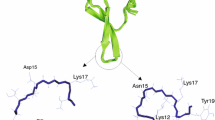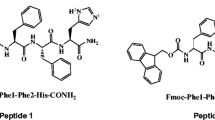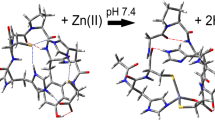Abstract
The human Pin1 WW domain catalyzes the cis–trans isomerization of the proline peptide bond. In this study, the conformation and binding of Cu(II) ions by Pin1 were investigated. It has been found that the affinity of peptide fragments of the human Pin1 WW domain for Cu(II) ions depends on its conformation. In particular, we analyzed three peptides derived from human Pin1: the nonapeptide hPin1(14–22) (with sequence Arg-Met-Ser-Arg-Ser-Ser-Gly-Arg-Val-NH2, peptide 1) the undecapeptide hPin1(13–23) (with sequence Lys-Arg-Met-Ser-Arg-Ser-Ser-Gly-Arg-Val-Tyr-NH2, peptide 2) and its derivative Ala13Ala23hPin1(13–23) (with sequence Ala-Arg-Met-Ser-Arg-Ser-Ser-Gly-Arg-Val-Ala-NH2, peptide 3) to study the role of presence in the sequence of the flanked residues at the N- and C-terminus, i.e., Lys13 and Tyr23. The presence of heat-capacity peaks found by DSC measurements for the systems studied strongly suggests that the conformational equilibria of the peptides studied strongly depend on the temperature. NMR spectroscopy and molecular dynamics simulations were instrumental to verify the conformational preferences of three peptides. The absence of likely or oppositely charged groups at the ends of a short chain fragment destroys chain reversal because the charged groups probably screen the nonpolar core from the solvent. ITC experiment was used to study the interactions with Cu(II) ions. It was found that the most stable complexes with Cu2+ ions are formed with peptide 2, which has the most bent conformation.






Similar content being viewed by others
Abbreviations
- hPin1:
-
Human cell regulatory protein
- SPPS:
-
Solid-phase peptide synthesis
- DSC:
-
Differential scanning calorimetry
- C p :
-
Heat of capacity
- T m :
-
Melting temperature
- ITC:
-
Isothermal titration calorimetry
- Mes:
-
2-(N-morpholino)ethanesulfonic acid
- NMR:
-
Nuclear magnetic resonance
- TOCSY:
-
Two-dimensional nuclear magnetic resonance spectroscopy
- ROESY:
-
Rotating frame nuclear Overhauser effect spectroscopy
- DQF-COSY:
-
Double-quantum filtered correlation spectroscopy
- CD:
-
Circular dichroism
- MD:
-
Molecular dynamic simulation
- rmsd:
-
Root-mean-square deviation
References
Blanco FJ, Rivas G, Serrano L. A short linear peptide that folds into a native stable beta-hairpin in aqueous solution. Nat Struct Biol. 1994;1:584–90.
Searle MS, Williams DH, Packman LC. A short linear peptide derived from the N-terminal sequence of ubiquitin folds into a water-stable non-native beta-hairpin. Nat Struct Biol. 1995;2:999–1006.
Skwierawska A, Makowska J, Ołdziej S, Liwo A, Scheraga HA. Mechanism of formation of the C-terminal β-hairpin of the B3 domain of the immunoglobulin binding protein G from Streptococcus. I. Importance of hydrophobic interactions in stabilization of beta-hairpin structure. Proteins Struct Funct Bioinform. 2009;75(4):931–53.
Lu KP, Hanes SD, Hunter T. A human peptidyl–prolyl isomerase essential for regulation of mitosis. Nature. 1996;380:544–7.
Lu KP, Liou YC, Zhou XZ. Pinning down the proline-directed phosphorylation signaling. Trends Cell Biol. 2002;12:164–72.
Lu KP. Prolyl isomerase Pin1 as a molecular target for cancer diagnostics and therapeutics. Cancer Cell. 2003;4:175–80.
Lu KP, Liou YC, Vincent I. Proline-directed phosphorylation and isomerization in mitotic regulation and in Alzheimer’s disease. BioEssays. 2003;25:174–81.
Liou IC, Sun A, Ryo A, Zhou XZ, Yu ZX, Huang HK, Uchida T, Bronson R, Bing G, Li X, Hunter T, Lu KP. Role of the prolyl isomerase Pin1 in protecting against age-dependent neurodegeneration. Nature. 2003;424:556–61.
Lu KP. Pinning down cell signaling, cancer and Alzheimer’s disease. Trends Biochem Sci. 2004;29:200–9.
Scheinberg H. Wilson’s disease and the physiological chemistry of copper. Inorganic chemistry in biology and medicine. ACS Symp Ser. 1980;140:373–80.
Crisponi G, Nurchi VM, Fanni D, Gerosa C, Nemolato S, Faa G. Copper-related diseases: from chemistry to molecular pathology. Coord Chem Rev. 2010;254:876–89.
Laurie SH, Lund T, Raynor JB. Electronic absorption and electron spin resonance studies on the interaction between the biologically relevant copper(II) glycylglycine and l-histidine complexes with D-penicillamine. J Chem Soc, Dalton Trans. 1975;14:1389–94.
Belosi B, Gaggelli E, Guerrini R, Kozłowski H, Łuczkowski M, Mancini FM, Remelli M, Valensin D, Valensin G. Copper binding to the neurotoxic peptide PrP106-126 thermodynamic and structural studies. Chem Bio Chem. 2004;5:349–59.
Remelli M, Donatoni M, Guerrini R, Janicka A, Pretegiani P, Kozłowski H. Copper-ion interaction with the 106–113 domain of the prion protein: a solution-equilibria study on model peptides. Dalton Trans. 2005;17:2876–85.
Kozłowski H, Janicka-Kłos A, Stańczak P, Valensin D, Valensin G, Kulon K. Specificity in the Cu2+ interactions with prion protein fragments and related His-rich peptides from mammals to fishes. Coord Chem Rev. 2008;252:1069–78.
Gumienna-Kontecka E, Nurchi VM, Szebesczyk A, Bilska P, Krzywoszyńska K, Kozłowski H. Chelating agents as tools for the treatment of metal overload. Z Anorg Allg Chem. 2013;639:1321–31.
Atwood CS, Moir RD, Huang X, Scarpa RC, Bacarra NME, Romano DM, Hartshorn MA, Tanzi RE. Bush AI dramatic aggregation of Alzheimer Aβ by Cu(II) is induced by conditions representing physiological acidosis. J Biol Chem. 1998;273:12817–26.
Choi J-S, Braymer JJ, Nanga RPR, Ramamoorthy A, Lim MH. Design of small molecules that target metal-Aβ species and regulate metal-induced Aβ aggregation and neurotoxicity. Proc Natl Acad Sci. 2010;107:21990–5.
Makowska J, Bagińska K, Liwo A, Chmurzyński L, Scheraga HA. Acidic–basic properties of three alanine-based peptides containing acidic and basic side chains: comparison between theory and experiment. Biopolym Pept Sci. 2008;90:724–32.
Makowska J, Bagińska K, Skwierawska A, Liwo A, Chmurzyński L, Scheraga HA. Influence of charge and size of terminal amino-acid residues on local conformational states and shape of alanine-based peptides. Biopolym Pept Sci. 2008;90:772–82.
Plotnikov V, Rochalski A, Brandts M, Brandts JF, Williston S, Frasca V, Lin LN. An autosampling differential scanning calorimeter instrument for studying molecular interactions. Assay Drug Dev Technol. 2002;1:83–90.
Goddard TD, Kneller DG, SPARKY3. San Francisco: University of California; 2001.
Güntert P, Brawn W, Wüthrich K. Efficient computation of three-dimensional protein structures in solution from nuclear magnetic resonance data using program DIANA and the supporting programs CALIBA, HABAS and GLOMSA. J Mol Biol. 1991;217:517–30.
Güntert P, Mumenthaler C, Wüthrich K. Torsion angle dynamics for NMR structure calculation with the new program DYANA. J Mol Biol. 1997;273:283–98.
Bystrov VF. Prog Nucl Magn Reson Spectrosc. 1976, 41–81.
Güntert P, Wüthrich K. Improved efficiency of protein structure calculations from NMR data using the program DIANA with redundant dihedral angle constraints. J Biomol NMR. 1991;1:447–56.
Case DA, Darden TA, Cheatham TE III, Simmerling CL, Wang J, Duke RE, Luo R, Walker RC, Zhang W, Merz KM, Roberts B, Wang B, Hayik S, Roitberg A, Seabra G, Kolossváry I, Wong KF, Paesani F, Vanicek J, Liu J, Wu X, Brozell SR, Steinbrecher T, Gohlke H, Cai Q, Ye X, Wang J, Hsieh MJ, Cui G, Roe DR, Mathews DH, Seetin MG, Sagui C, Babin V, Luchko T, Gusarov S, Kovalenko A, Kollman PA. AMBER 11. San Francisco: University of California; 2010.
Weiner SJ, Kollman PA, Nguyen DT, Case DA. An all atom force field for simulations of proteins and nucleic acid. J Comput Chem. 1986;7:230–52.
Jorgensen WL, Chandrasekhar J, Madura JD, Impey RW, Klein ML. Comparison of simple potential functions for simulating liquid water. J Chem Phys. 1983;79:926–35.
Ewald P. Die Berchnung optischer und elektrostatischer Gitterpotentiale. Ann Phys. 1921;64:253–87.
Darden T, York D, Pedersen L. Particle Mesh Ewald: an N-log(N) method for Ewald sums in large systems. J Chem Phys. 1993;98:10089–92.
Torda AE, Scheek RM, van Gunsteren WF. Time-dependent distance restraints in molecular-dynamics simulations. Chem Phys Lett. 1989;57:289–94.
Pearlman DA, Kollman PA. Are time-averaged restraints necessary for nuclear-magnetic-resonance refinement a model study for DNA. J Mol Biol. 1991;220:457–79.
Koradi R, Billeter M, Wuthrich K. MOLMOL: a program for display and analysis of macromolecular structures. J Mol Graph. 1996;14:51–5.
Shamos MI, Hoey D. Closest-point problems. In: Proceedings of 16th annual IEEE symposium on the foundations of computer science. 1975. AQ6, p. 151–62.
Rohlf FJ. A probabilistic minimum spanning tree algorithm. Inform Process Lett. 1978;7:44–9.
Bentley JL, Friedman JH. Fast algorithms for constructing minimal spanning trees in coordinate spaces. IEEE Trans Comput. C-27. 1978;6:97–105.
Bentley JL, Weide BW, Yao AC. Optimal expected-time algorithms for closest point problems. ACM Trans Math Softw. 1980;6:563–80.
Wyrzykowski D, Zarzeczańska D, Jacewicz D, Chmurzyński L. Investigation of copper(II) complexation by glycylglycine using isothermal titration calorimetry. J Therm Anal Calorim. 2011;105:1043–7.
Wyrzykowski D, Pilarski B, Jacewicz D, Chmurzyński L. Investigation of metal–buffer interactions using isothermal titration calorimetry. J Therm Anal Calorim. 2013;111:1829–36.
Scholtz JM, Marqusee S, Baldwin RL, York EJ, Stewart JM, Santoro M, Bolen DW. Calorimetric determination of the enthalpy change for the α-helix to coil transition of an alanine peptide in water. PNAS. 1991;88:2854–8.
La Rosa C, Milardi D, Grasso DJ, Guzzi R, Sportelli L. Thermodynamics of the thermal unfolding of azurin. J Phys Chem. 1995;99:14864–70.
Wüthrich K. NMR of proteins and nucleic acids. New York: Wiley; 1986.
Wyrzykowski D, Tesmar A, Jacewicz D, Pranczk J, Chmurzyński L. Zinc(II) complexation by some biologically relevant pH buffers. J Mol Recognit. 2014;27:722–6.
Mash HE, Chin YP. Complexation of copper by zwitter ionic aminosulfonic (Good) buffers. Anal Chem. 2003;75:671–7.
Goldberg RN, Kishore N, Lennen RM. Thermodynamic quantities for the ionization reactions of buffers. J Phys Chem. 2002;31:231–70.
Wyrzykowski D, Anusiewicz I, Pilarski B, Jacewicz D, Chmurzyński L. Investigations of coordinating properties of oxydiacetate and thiodiacetate anions towards Zn2+ ions in solutions. Inorg Chem Acta. 2013;405:163–8.
Makowska J, Żmudzińska W, Uber D, Chmurzyński L. A study of the influence of charged residues on beta-hairpin formation by nuclear magnetic resonance and molecular dynamics. Protein J. 2014;33:525–35.
Wilson KA, Bouchard JJ, Peng JW. Interdomain interactions support interdomain communication in human Pin1. Biochemistry. 2013;52:6968–81.
Acknowledgements
Calculations were carried out using the resources of the Informatics Center of the Metropolitan Academic Network (IC MAN) in Gdansk. Fondazione Ente Cassa di Risparmio di Firenze is greatly acknowledged for supporting Pept Lab of the University of Florence. Moreover, the Erasmus Program 2014 is acknowledged for the traineeship fellowship of DU in Pept Lab at the University of Florence.
Author information
Authors and Affiliations
Corresponding author
Electronic supplementary material
Below is the link to the electronic supplementary material.
Rights and permissions
About this article
Cite this article
Uber, D., Wyrzykowski, D., Tiberi, C. et al. Conformation-dependent affinity of Cu(II) ions peptide complexes derived from the human Pin1 protein. J Therm Anal Calorim 127, 1431–1443 (2017). https://doi.org/10.1007/s10973-016-5387-9
Received:
Accepted:
Published:
Issue Date:
DOI: https://doi.org/10.1007/s10973-016-5387-9




